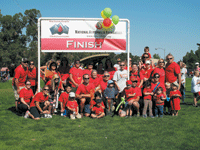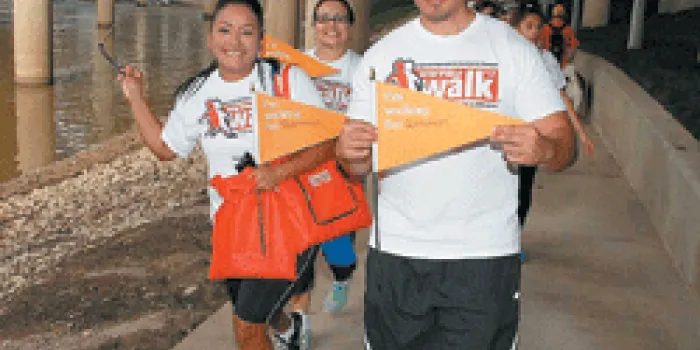It has been five years since the National Hemophilia Foundation (NHF) launched its Hemophilia Walk program, starting with five walks, held in New York City, Phoenix, Cleveland, Raleigh and Houston. During the first Walk season, about 2,700 walkers, and national and local sponsors raised more than $1 million in support of their chapters. It was a promising beginning.
Since then, the Walk program has been growing at an impressive rate. This year, chapters across the US will host 23 Walks. At press time, 8,000 people had registered to walk, and the chapters had raised $1.3 million.
The Houston-based Lone Star Chapter of NHF was one of the founding chapters of the Hemophilia Walk program. Melissa Compton, who has served as Walk manager since the program’s inception, recalls the trepidation she felt before her chapter’s first Walk. “NHF set a fundraising goal of $50,000 for us. I thought it was completely out of reach,” she says. “We had never raised that much money before.” But the Lone Star Chapter ended up quadrupling that amount, raising approximately $205,000 that year. Further, nearly 1,000 walkers participated in the inaugural Walk.
Then in 2011, the Lone Star Chapter doubled its efforts, hosting two Walks to accommodate more people in its large geographic area. “We’re located in Houston, but our territory goes east to the Louisiana-Texas border, north up to Waco, west to El Paso and everything south down to Mexico.” A second Walk in Austin allowed some families to attend without having to travel or spend the weekend in a hotel. The first Austin Walk, Compton said, attracted about 225 participants; this year, they are expecting close to 400. The total number of expected participants for both Walks is 1,400.
Brad Benne, executive director of the Rocky Mountain Hemophilia & Bleeding Disorders Association in Bozeman, Montana, says his chapter has experienced challenges similar to the Lone Star Chapter. His chapter encompasses all of Montana and Wyoming; many members travel long distances for fundraising and educational events.
“We are small, but mighty,” Benne says. The chapter held its first Walk on September 8, 2012. At first, Benne was somewhat apprehensive about the small chapter’s ability to generate enough interest and volunteers to plan and participate in a Walk. Then he realized the potential benefits were too great to ignore. “Our board of directors saw it as another way for our chapter to sustain itself,” he says.
The Rocky Mountain chapter has held successful fundraisers before but nothing on the scale of the Walk. “Most of our fundraisers bring in about $2,000,” he says. “If our Walk raises $20,000, that will be a huge success for us.” The chapter, in fact, raised more than $25,000.

The Blood Brothers team
raised more than $4,500 for
the Montana Walk.
Walks bring more than money to the chapters. They can add members, too. “Walks are a great way for families to get more involved with our chapter,” Compton says. Families with newly diagnosed children can feel overwhelmed at educational events, but Walks allow them to participate, she says. In addition, kids with bleeding disorders meet each other and families bond. “New families have gotten to know us through our Walks and then will start coming to our other events,” says Compton.
Walks also help make bleeding disorders more visible in the community. “My goal of the Walk is to spread awareness of bleeding disorders to every corner of Montana and Wyoming,” Benne says. The reasons are practical as well as aspirational. For many chapter members, the hemophilia treatment center in Denver, Colorado, is an 11-hour drive. “People wind up going to local hospitals and emergency rooms that aren’t as knowledgeable as they could be about bleeding disorders,” Benne says. “The Walk is a great opportunity for our chapter and community to get their stories out there.”
Five more chapters will be hosting Walks in 2013: Bleeding Disorder Foundation of Washington in Edmonds; Hemophilia Association of the Capital Area in Fairfax, Virginia; Hemophilia Foundation of Oregon in Portland; Hemophilia Association of San Diego County in San Diego; Sangre de Oro, Inc., Hemophilia Foundation of New Mexico in Albuquerque; and the Midwest Hemophilia Association in Leawood, Kansas.
The Walks are supported by National Presenting Sponsor Baxter, Pacesetter Sponsor Bayer HealthCare, Official Sponsors Pfizer Hemophilia and Grifols, and Supporting Sponsor Biogen Idec Hemophilia. For more information and to find a Walk in your area, go to: hemophilia.org/walk.

